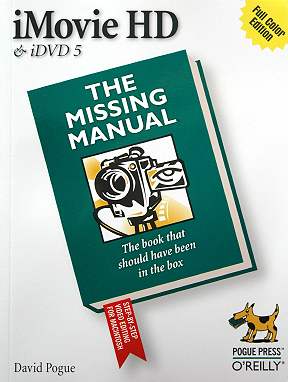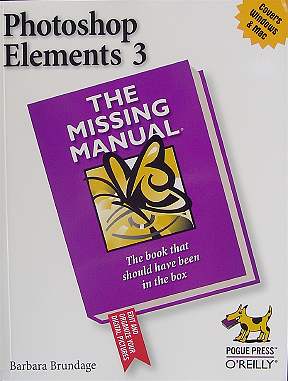eXtensions
|
Missing Manuals for the non-Professional Visual Artist
|
By Graham K. Rogers
Brundage, Barbara. Photoshop Elements 3: The Missing Manual. O'Reilly; Sabastopol, CA. US$39.95. ISBN 0-596-00453-2
Pogue, David. iMovieHD and iDVD: The Missing Manual. O'Reilly; Sabastopol, CA. US$29.95. ISBN 0-596-10033-7
After the excitement of the Intel announcement and updates both to applications and to Tiger (10.4.2), it is time to look at books.
 The update to iLife'05 has been covered in several columns and we have already reviewed the iPhoto and iTunes/iPod Missing Manuals. In that same series is iMovie HD and iDVD: the Missing Manual. The HD in the title indicates that the application is ready to handle the new generation of video cameras: those that create High Definition TV images. iDVD (almost hidden in the title) is the Apple software for making our DVD movies and, if we have the hardware, burning them to disk.
The update to iLife'05 has been covered in several columns and we have already reviewed the iPhoto and iTunes/iPod Missing Manuals. In that same series is iMovie HD and iDVD: the Missing Manual. The HD in the title indicates that the application is ready to handle the new generation of video cameras: those that create High Definition TV images. iDVD (almost hidden in the title) is the Apple software for making our DVD movies and, if we have the hardware, burning them to disk.
The last time I handled any moving images was with 8mm and Super-8 cameras. We do have modern cameras at work, however. I prefer still images, but I have used earlier versions of iMovie. Like iPhoto, it is straight-forward and enough for the amateur. With iMovie, too, the enthusiast (as opposed to the professional) can make full use of the tools that are part of the installation. Indeed, this Missing Manual shows that professional software some users acquire is far more than they will ever need.
Like photography books, this takes a logical approach to camera techniques and then editing: how to assemble a movie. There need not be a linear approach (the ending can be shot before the introduction) and the Missing Manual has several chapters that detail the "how" of these processes.
I particularly liked the "less is more" warning concerning transitions: links between clips. The authors compared the risks here to the advent of font choices on early Macs. The huge choices available are a temptation. The same warning is given for effects (rain, sepia, scratches).
Section three covers what one might call distribution media. Not that many iMovie creations will make it to the Scala or Lido (a couple have won international prizes) -- movie houses in the Siam area of Bangkok. This looks at more down-to-earth media such as the VCR, mobile phones and movies on the web, as well as using QuickTime.
The final section covers iDVD: another of the bundled Apple programs. The DVD can also be used to store data of course. Preparing a movie for burning to a disk (and using data) are covered here in a lengthy section of 100 pages: 20% of the book length.
Pogue, and his co-author Erica Sadun, have a good touch here, looking carefully at the newer technologies and transitions available to iDVD users. Early in the book, they also look at iMovie's new little trick: Magic Movie. This allows a user to connect the camera, select transitions and any music from iTunes, and have the whole movie assembled then burned onto a DVD disk (forego the burning if desired). Despite its apparent simplicity, they take good care to explain how to set this up for good results.
As befits a digital imaging book, the pages are of a better quality paper with really high quality images: all in colour. Those images are used to excellent effect in explaining techniques. The book is a little heavy (over 500 pages) with a good index as is usual in Missing Manuals. Also as usual are the appendices: on menus, troubleshooting and key-commands. The price is in line with other books in the series.
 As I write above, I am not a believer in overloading my computers with software. In Thailand most users act as if the only application for photo manipulation is Adobe Photoshop.
As I write above, I am not a believer in overloading my computers with software. In Thailand most users act as if the only application for photo manipulation is Adobe Photoshop.
It most certainly is if you are professional, but for those of us with smaller digital cameras, apart from resizing and changing contrast/brightness, most of the program's strengths go unused.
I spent some time using Adobe Photoshop Elements (v2) a while back and when version 3 was released tried quite hard to buy it. Blank stares everywhere.
There are dealers in town but these are not readily accessible -- where is a legal copy of Elements in Phantip or Fortune Town? One answer might be the bundled software that comes with certain scanners.
If this is how Elements comes your way, you will need this book, Photoshop Elements 3: The Missing Manual, to make you realise just how strong a program it really is. It handles RAW images, the digital "negatives" from which to work; and has almost all of the tools that us non-professionals will require, and many they will not.
Like the other digital photography missing manuals, this is printed on high quality paper with a good selection of images. It has screen shots from both OSX and Windows XP. Where there are any differences in the respective installations, these are clearly explained.
This is about the same size and weight as the iMovie book (above) although the price is greater. Nonetheless, for such detail, this would be a sound investment for an Elements user.

For further information, e-mail
to Graham K. Rogers.
Back to
eXtensions
To
eXtensions: Book Reviews
To
eXtensions: Year One
To
eXtensions: Year Two
Back to homepage
 The update to iLife'05 has been covered in several columns and we have already reviewed the iPhoto and iTunes/iPod Missing Manuals. In that same series is iMovie HD and iDVD: the Missing Manual. The HD in the title indicates that the application is ready to handle the new generation of video cameras: those that create High Definition TV images. iDVD (almost hidden in the title) is the Apple software for making our DVD movies and, if we have the hardware, burning them to disk.
The update to iLife'05 has been covered in several columns and we have already reviewed the iPhoto and iTunes/iPod Missing Manuals. In that same series is iMovie HD and iDVD: the Missing Manual. The HD in the title indicates that the application is ready to handle the new generation of video cameras: those that create High Definition TV images. iDVD (almost hidden in the title) is the Apple software for making our DVD movies and, if we have the hardware, burning them to disk. As I write above, I am not a believer in overloading my computers with software. In Thailand most users act as if the only application for photo manipulation is
As I write above, I am not a believer in overloading my computers with software. In Thailand most users act as if the only application for photo manipulation is 